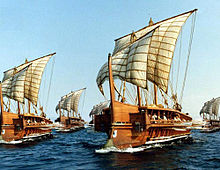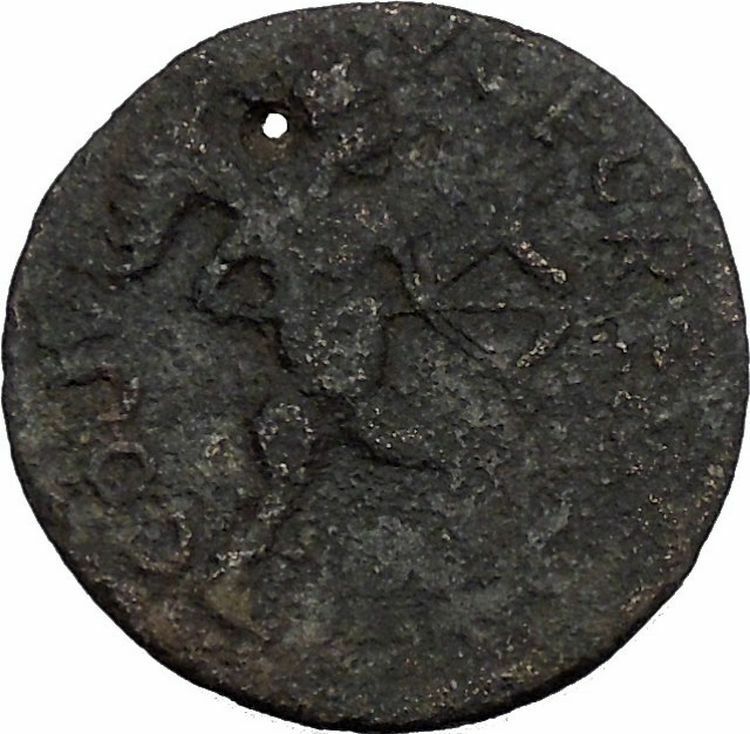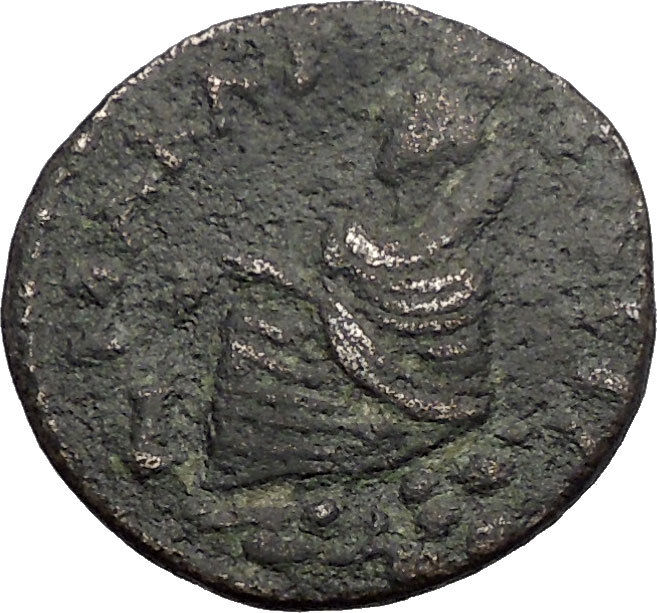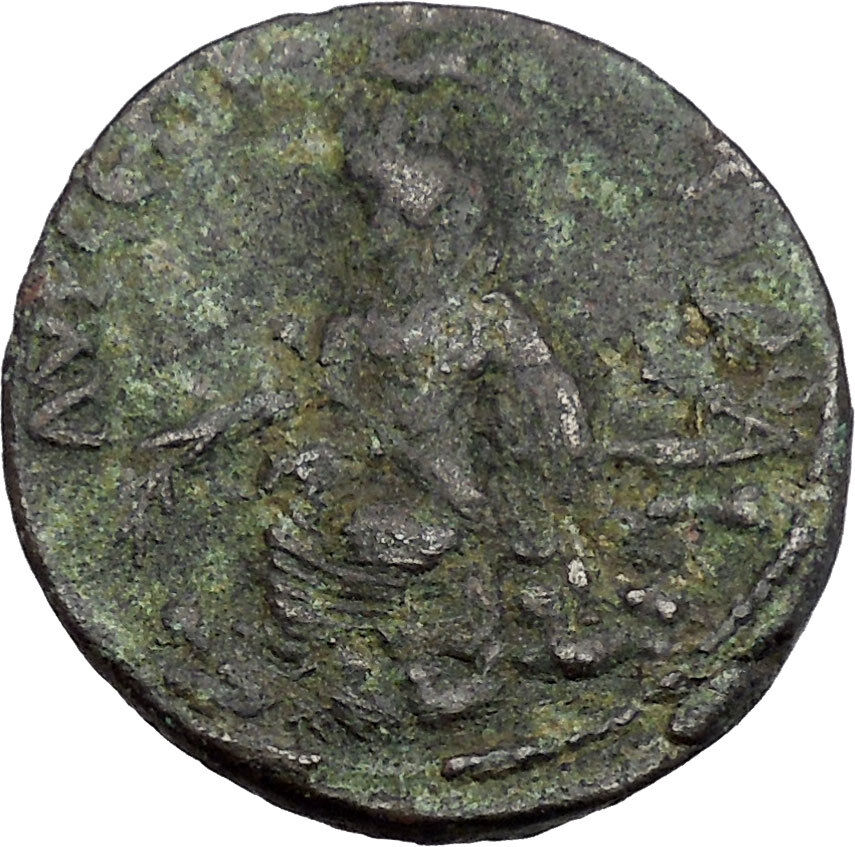|
Greek city of Ascalon in Judaea
Bronze 14.3mm (2.40 grams) Pseudo-autonomous issue. time of Vespasian 69-79 A.D.
Dated CY 180, struck 76/77 A.D.
Reference: Rosenberger 55; SNG ANS 683-687; RPC II 2205
Veiled and turreted bust of Tyche right.
Galley right; ΠΡ (date) above AΣ.
You are bidding on the exact item pictured, provided with a Certificate of Authenticity and Lifetime Guarantee of Authenticity.
 Tyche (meaning “luck”; Roman equivalent: Fortuna) was the presiding tutelary deity that governed the fortune and prosperity of a city, its destiny. She is the daughter of Aphrodite and Zeus or Hermes. Tyche (meaning “luck”; Roman equivalent: Fortuna) was the presiding tutelary deity that governed the fortune and prosperity of a city, its destiny. She is the daughter of Aphrodite and Zeus or Hermes.
In literature, she might be given various genealogies, as a daughter of Hermes and Aphrodite, or considered as one of the Oceanids, daughters of Oceanus and Tethys, or of Zeus. She was connected with Nemesis and Agathos Daimon (“good spirit”).
The Greek historian Polybius believed that when no cause can be discovered to events such as floods, droughts, frosts or even in politics, then the cause of these events may be fairly attributed to Tyche.
 A galley is a type of ship propelled by rowers that originated in the eastern Mediterranean Sea and was used for warfare, trade and piracy from the first millennium BC. Galleys dominated naval warfare in the Mediterranean from the 8th century BC until development of advanced sailing warships in the 17th century. Galleys fought in the wars of Assyria, ancient Phoenicia, Greece, Carthage and Rome until the 4th century AD. After the fall of the Western Roman Empire galleys formed the mainstay of the Byzantine navy and other navies of successors of the Roman Empire, as well as new Muslim navies. Medieval Mediterranean states, notably the Italian maritime republics, including Venice, Pisa, Genoa and the Ottoman Empire relied on them as the primary warships of their fleets until the 17th century, when they were gradually replaced by sailing warships. Galleys continued to be applied in minor roles in the Mediterranean and the Baltic Sea even after the introduction of steam propelled ships in the early 19th century. A galley is a type of ship propelled by rowers that originated in the eastern Mediterranean Sea and was used for warfare, trade and piracy from the first millennium BC. Galleys dominated naval warfare in the Mediterranean from the 8th century BC until development of advanced sailing warships in the 17th century. Galleys fought in the wars of Assyria, ancient Phoenicia, Greece, Carthage and Rome until the 4th century AD. After the fall of the Western Roman Empire galleys formed the mainstay of the Byzantine navy and other navies of successors of the Roman Empire, as well as new Muslim navies. Medieval Mediterranean states, notably the Italian maritime republics, including Venice, Pisa, Genoa and the Ottoman Empire relied on them as the primary warships of their fleets until the 17th century, when they were gradually replaced by sailing warships. Galleys continued to be applied in minor roles in the Mediterranean and the Baltic Sea even after the introduction of steam propelled ships in the early 19th century.
The galley engagements at Actium and Lepanto are among the greatest naval battles in history.
Ashkelon (also spelled Ashqelon and Ascalon; Hebrew: אַשְׁקְלוֹן; Arabicc: عَسْقَلَان ʿAsqalān) is a coastal city in the Southern District of Israel on the Mediterranean coast, 50 kilometres (31 mi) south of Tel Aviv, and 13 kilometres (8.1 mi) north of the border with the Gaza Strip. The ancient seaport of Ashkelon dates back to the Neolithic Age. In the course of its history, it has been ruled by the Ancient Egyptians, the Canaanites, the Philistines, the Assyrians, the Babylonians, the Greeks, the Phoenicians, the Hasmoneans, the Romans, the Persians, the Arabs and the Crusaders, until it was destroyed by the Mamluks in 1270.
The name Ashkelon is probably western Semitic, and might be connected to the root š-q-l (“to weigh” from a Semitic root ṯql, akin to Hebrew šāqal שָקַל or Arabic θiql ثِقْل “weight”) perhaps attesting to its importance as a center for mercantile activities. Scallion and shallot are derived from Ascalonia, the Latin name for Ashkelon.
Ashkelon became one of the five Philistine cities that were constantly warring with the Israelites and the Kingdom of Judah. According to Herodotus, its temple of Venus was the oldest of its kind, imitated even in Cyprus, and he mentions that this temple was pillaged by marauding Scythians during the time of their sway over the Medes (653-625 BC). As it was the last of the Philistine cities to hold out against Babylonian king Nebuchadnezzar II. When it fell in 604 BC, burnt and destroyed and its people taken into exile, the Philistine era was over.
Ashkelon was soon rebuilt. Until the conquest of Alexander the Great, Ashkelon’s inhabitants were influenced by the dominant Persian culture. It is in this archaeological layer that excavations have found dog burials. It is believed the dogs may have had a sacred role, however evidence is not conclusive. After the conquest of Alexander in the 4th century BC, Ashkelon was an important free city and Hellenistic seaport.
It had mostly friendly relations with the Hasmonean kingdom and Herodian kingdom of Judea, in the 2nd and 1st centuries BC. In a significant case of an early witch-hunt, during the reign of the Hasmonean queen Salome Alexandra, the court of Simeon ben Shetach sentenced to death eighty women in Ashkelon who had been charged with sorcery. Herod the Great, who became a client king of Rome over Judea and its surrounds in 30 BC, had not received Ashkelon, yet he built monumental buildings there: bath houses, elaborate fountains and large colonnades. A discredited tradition suggests Ashkelon has been his birthplace. In 6 CE, when a Roman imperial province was set in Judea, overseen by a lower-rank governor, Ashkelon was moved directly to the higher jurisdiction of the governor of Syria province.
The city remained loyal to Rome during the Great Revolt, 66-70 AD.
|





 Tyche (meaning “luck”; Roman equivalent: Fortuna) was the presiding tutelary deity that governed the fortune and prosperity of a city, its destiny. She is the daughter of Aphrodite and Zeus or Hermes.
Tyche (meaning “luck”; Roman equivalent: Fortuna) was the presiding tutelary deity that governed the fortune and prosperity of a city, its destiny. She is the daughter of Aphrodite and Zeus or Hermes. A galley is a type of ship propelled by rowers that originated in the eastern Mediterranean Sea and was used for warfare, trade and piracy from the first millennium BC. Galleys dominated naval warfare in the Mediterranean from the 8th century BC until development of advanced sailing warships in the 17th century. Galleys fought in the wars of Assyria, ancient Phoenicia, Greece, Carthage and Rome until the 4th century AD. After the fall of the Western Roman Empire galleys formed the mainstay of the Byzantine navy and other navies of successors of the Roman Empire, as well as new Muslim navies. Medieval Mediterranean states, notably the Italian maritime republics, including Venice, Pisa, Genoa and the Ottoman Empire relied on them as the primary warships of their fleets until the 17th century, when they were gradually replaced by sailing warships. Galleys continued to be applied in minor roles in the Mediterranean and the Baltic Sea even after the introduction of steam propelled ships in the early 19th century.
A galley is a type of ship propelled by rowers that originated in the eastern Mediterranean Sea and was used for warfare, trade and piracy from the first millennium BC. Galleys dominated naval warfare in the Mediterranean from the 8th century BC until development of advanced sailing warships in the 17th century. Galleys fought in the wars of Assyria, ancient Phoenicia, Greece, Carthage and Rome until the 4th century AD. After the fall of the Western Roman Empire galleys formed the mainstay of the Byzantine navy and other navies of successors of the Roman Empire, as well as new Muslim navies. Medieval Mediterranean states, notably the Italian maritime republics, including Venice, Pisa, Genoa and the Ottoman Empire relied on them as the primary warships of their fleets until the 17th century, when they were gradually replaced by sailing warships. Galleys continued to be applied in minor roles in the Mediterranean and the Baltic Sea even after the introduction of steam propelled ships in the early 19th century.




